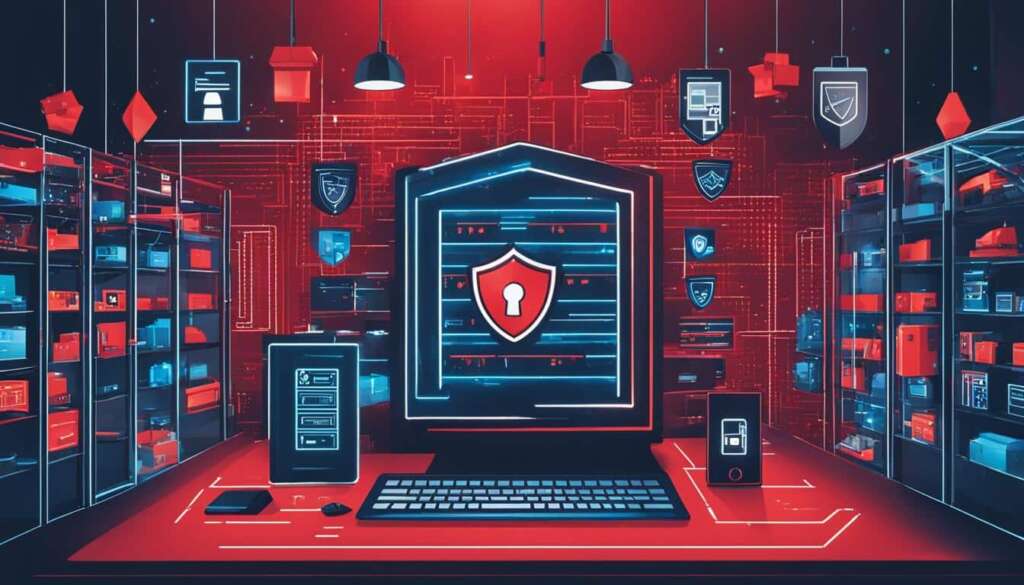Table of Contents
The retail industry is experiencing rapid growth, particularly with the transition to online shopping due to the COVID-19 pandemic. However, this digital transformation has also brought along increased cybersecurity risks. Retail businesses handle vast amounts of personal and financial data, making them attractive targets for cybercriminals.
Cybersecurity in the retail industry is a critical concern. From social engineering attacks to ransomware and insider threats, retail businesses face a wide range of cyber threats that can result in security breaches and data compromises. It is essential for retailers to implement robust cybersecurity measures to protect their sensitive information and maintain customer trust.
In this article, we will explore the various cybersecurity challenges faced by the retail industry and provide effective solutions to mitigate these risks. By addressing these challenges and adopting best practices, retailers can safeguard their valuable data and defend against cyber attacks.
Social Engineering and Phishing: Threats to Retail Cybersecurity
The retail industry faces numerous cybersecurity challenges, and one of the most prominent is social engineering, particularly phishing attacks. Cybercriminals use clever tactics to deceive customers and gain unauthorized access to sensitive information. Phishing attacks involve the use of fraudulent emails, messages, or phone calls to trick individuals into providing personal or financial details. These attacks often target unsuspecting retail customers, who may unknowingly disclose their credit card information, login credentials, or other sensitive data.
Phishing attacks pose significant threats to the retail industry, as they can lead to further cyberattacks on the targeted organization and its associated parties. Once cybercriminals obtain access credentials, they may exploit vulnerabilities in retail systems, compromising customer data, and causing severe financial and reputational damage. Retail businesses must be vigilant and implement robust security measures to protect against social engineering attacks.
To safeguard against phishing attacks, retail organizations should educate their customers and employees about the dangers of social engineering. Training programs can help individuals recognize suspicious emails, messages, or phone calls and understand the importance of verifying the authenticity of requests for personal information. Additionally, implementing multi-factor authentication, regularly updating security protocols, and utilizing advanced email filtering systems can significantly reduce the risk of successful phishing attacks.
Ransomware Attacks: A Growing Threat to Retail Businesses

Ransomware poses a significant cybersecurity threat to the retail industry. This malicious software is designed to encrypt valuable data and hold it hostage until a ransom is paid. The retail sector is an attractive target for cybercriminals due to the vast amount of sensitive customer information that businesses store, including personal and financial data. Without adequate protection, retail businesses are vulnerable to devastating ransomware attacks that can disrupt operations, compromise customer trust, and result in significant financial losses.
The Impact of Ransomware Attacks
Ransomware attacks can have severe consequences for retail businesses. These attacks can lead to data loss, operational disruptions, reputational damage, and financial liabilities. Retailers may be forced to pay substantial ransoms to regain access to their encrypted data, draining valuable resources. Even if the ransom is paid, there is no guarantee that the attackers will release the data or refrain from further attacks. Additionally, the public disclosure of a ransomware attack can damage a retailer’s reputation and erode customer trust, leading to a loss of business.
Retail Cybersecurity Measures
To protect against ransomware attacks, retail businesses must implement robust cybersecurity measures. These include:
- Regularly updating and patching software to address vulnerabilities
- Conducting employee training and awareness programs to educate staff about the risks of phishing emails and suspicious downloads
- Implementing strong access controls and multi-factor authentication to prevent unauthorized access to sensitive systems
- Backing up critical data regularly and storing backups offline or in secure cloud storage
- Monitoring network traffic for signs of suspicious activity and promptly investigating any potential breaches
By proactively taking these cybersecurity measures, retail businesses can significantly reduce their risk of falling victim to ransomware attacks and protect their valuable data.
| Ransomware Protection Strategies | Description |
|---|---|
| Backup and Recovery | Regularly back up critical data and test the restoration process to ensure data can be recovered in the event of a ransomware attack. |
| Network Segmentation | Segmenting the network can limit the spread of ransomware by isolating infected systems and minimizing the potential impact on the entire network. |
| Endpoint Protection | Implementing endpoint protection solutions, such as advanced antivirus software and behavioral analysis tools, can help detect and block ransomware attacks at the endpoint. |
| Email Filtering | Deploying email filtering solutions that can detect and block phishing emails can help prevent employees from inadvertently falling for ransomware-related social engineering attacks. |
| Employee Training | Regularly provide cybersecurity awareness training to educate employees about the risks and best practices for identifying and responding to ransomware threats. |
Securing NFC Payment Systems in Retail: Risks and Solutions
Near Field Communications (NFC) payment systems have gained popularity in the retail industry for their convenience and speed. However, along with their benefits come data security risks that retailers must address to protect customer payment information. Hackers can potentially exploit unsecured connections to access sensitive data stored on NFC payment terminals, putting both retailers and their customers at risk.
To mitigate the risks associated with NFC payment systems, retailers should implement robust security measures. One key solution is to ensure strong encryption protocols are in place to protect customer data. By encrypting the data at both the point of sale and during transmission, retailers can minimize the risk of interception and tampering.
Additionally, retailers should prioritize the use of secure connections for NFC payment systems. This can be achieved by exclusively using secure Wi-Fi networks or implementing point-to-point encryption technologies. By adopting these measures, retailers can significantly reduce the risk of unauthorized access to customer payment information.
Table: Comparison of NFC Payment System Security Solutions
| Security Solution | Benefits |
|---|---|
| Strong encryption protocols | – Protects customer data from interception and tampering |
| Secure connections | – Minimizes the risk of unauthorized access |
| Regular security audits | – Identifies vulnerabilities and ensures ongoing protection |
| User authentication and access controls | – Prevents unauthorized individuals from tampering with payment systems |
In addition to encryption and secure connections, regular security audits are essential to identify vulnerabilities and ensure ongoing protection. Retailers should regularly assess their NFC payment systems for any potential weaknesses and address them promptly.
By implementing these solutions and maintaining a proactive approach to cybersecurity, retailers can secure their NFC payment systems and protect customer data from unauthorized access.
Addressing Software Vulnerabilities in the Retail Industry
The retail industry relies heavily on software for various operations, from inventory management to online transactions. However, this reliance on software also opens up vulnerabilities that attackers can exploit. It’s essential for retail businesses to address these vulnerabilities and implement robust security measures to protect their systems and customer data.
Common Software Vulnerabilities in Retail
There are several common software vulnerabilities that retail businesses should be aware of:
- SQL Injection: Attackers can exploit vulnerabilities in a website’s database to manipulate or retrieve sensitive information.
- URL Redirection: Malicious actors can redirect users to a different website, potentially exposing them to phishing or malware attacks.
- Missing Authentication and Data Encryption: Insufficient authentication and data encryption methods can result in unauthorized access to sensitive data.
- Infected Software: Retailers must be cautious when using third-party software, as infected software can introduce malware into their systems.
- Weak Passwords: Weak passwords can easily be guessed or cracked, providing unauthorized access to systems and data.
By being aware of these vulnerabilities, retail businesses can take proactive steps to mitigate the associated risks.
Retail Cybersecurity Best Practices
To secure retail software and protect against vulnerabilities, implementing the following best practices is crucial:
- Regular Updates and Patches: Ensure that all software used in the retail environment is kept up to date with the latest security patches and updates.
- Security Audits: Conduct regular security audits to identify and address potential vulnerabilities in software systems.
- Secure Coding Practices: Train developers to follow secure coding practices, such as input validation and output sanitization, to prevent common vulnerabilities.
- Employee Awareness and Training: Educate employees about software vulnerabilities and the importance of following cybersecurity protocols.
- Third-Party Risk Assessment: Perform thorough risk assessments on any third-party software vendors, ensuring they have proper security measures in place.
By implementing these best practices, retail businesses can enhance their cybersecurity posture and reduce the risk of software vulnerabilities being exploited.
| Software Vulnerability | Risk Level | Recommended Mitigation |
|---|---|---|
| SQL Injection | High | Implement prepared statements and input validation to prevent SQL injection attacks. |
| URL Redirection | Medium | Validate and sanitize user-provided URLs to prevent malicious redirection. |
| Missing Authentication and Data Encryption | High | Implement strong authentication mechanisms and encrypt sensitive data both in transit and at rest. |
| Infected Software | High | Use reputable software vendors and regularly scan software for malware. |
| Weak Passwords | Medium | Enforce strong password policies and consider implementing multi-factor authentication. |
By being proactive and implementing these measures, retail businesses can significantly reduce the risk of software vulnerabilities and enhance their overall cybersecurity posture.
Retail Cybersecurity Strategies: Protecting Against Automation and Botnet Attacks
The retail industry is increasingly reliant on automation to streamline operations and enhance customer experiences. However, this reliance also presents new cybersecurity challenges. Retailers must be vigilant in protecting their networks from automation and botnet attacks, which can compromise sensitive data and disrupt business operations. Implementing effective cybersecurity strategies is essential to safeguard against these threats.
One key strategy is the implementation of multi-factor authentication (MFA). By requiring users to provide multiple forms of verification, such as a password and a unique code sent to their mobile device, retailers can significantly reduce the risk of unauthorized access. MFA adds an extra layer of protection against automated attacks and makes it more difficult for cybercriminals to gain control over retail networks.
“Multi-factor authentication is an essential security measure for retailers to defend against automation and botnet attacks. By implementing MFA, retailers can significantly enhance their network security and protect sensitive customer data.”
Another crucial aspect of retail cybersecurity is the use of intrusion detection systems (IDS). These systems monitor network traffic and identify any suspicious activity that may indicate an attack. By promptly detecting and responding to potential threats, retailers can minimize the impact of automation and botnet attacks, preventing data breaches and system disruptions.
Table: Comparison of Retail Cybersecurity Strategies
| Cybersecurity Strategy | Benefits |
|---|---|
| Multi-factor Authentication (MFA) | – Adds an extra layer of protection against automated attacks – Reduces the risk of unauthorized access |
| Intrusion Detection Systems (IDS) | – Monitors network traffic for suspicious activity – Promptly detects and responds to potential threats |
| Employee Training and Awareness | – Educates employees about cybersecurity best practices – Helps prevent human errors that can lead to automation and botnet attacks |
| Regular Security Audits | – Identifies vulnerabilities in retail networks – Allows for timely implementation of security patches and updates |
Employee training and awareness are also essential components of retail cybersecurity strategies. Retailers should provide comprehensive training programs to educate employees about cybersecurity best practices and the potential risks of automation and botnet attacks. By fostering a culture of cybersecurity awareness, retailers can empower their employees to identify and respond to potential threats, reducing the likelihood of successful attacks.
Regular security audits are crucial for maintaining robust cybersecurity in the retail industry. These audits help identify vulnerabilities in retail networks and allow for the timely implementation of security patches and updates. By regularly assessing the effectiveness of existing security measures, retailers can proactively address any weaknesses and ensure their networks are protected against automation and botnet attacks.

Managing Third-Party Risks in the Retail Industry
The retail industry heavily relies on third-party vendors, suppliers, and service providers to support various aspects of its operations. While these partnerships bring efficiency and convenience, they also introduce potential security risks to retail businesses. It is crucial for retailers to manage these third-party risks effectively to safeguard their sensitive data and maintain the trust of their customers.
The Importance of Supply Chain Cybersecurity
One of the key areas where third-party risks can arise in the retail industry is the supply chain. Retailers depend on suppliers and distributors to deliver products to their stores or customers, and any vulnerabilities in the supply chain can be exploited by cybercriminals. A breach in the supply chain can result in compromised product integrity, data breaches, and operational disruptions.
Implementing robust supply chain cybersecurity measures is essential to mitigate these risks. Retailers should conduct thorough vendor risk assessments to evaluate the security practices and protocols of their suppliers and distributors. This assessment should include an analysis of their data protection measures, cybersecurity training for employees, incident response plans, and their overall commitment to cybersecurity best practices.
Vendor Risk Assessment
A comprehensive vendor risk assessment helps retailers identify potential vulnerabilities and ensure that their third-party partners have adequate security measures in place. This assessment should include:
- Evaluating the vendor’s security policies and procedures
- Assessing the vendor’s track record in addressing cybersecurity incidents
- Verifying the vendor’s compliance with industry standards and regulations
- Reviewing the vendor’s incident response capabilities
By conducting a thorough vendor risk assessment, retailers can make informed decisions about their third-party partnerships and establish a robust supply chain cybersecurity framework. Regular audits and ongoing monitoring of vendor performance should also be implemented to ensure that security standards are maintained over time.
In Conclusion
Managing third-party risks is critical for the retail industry to protect customer data, maintain operational continuity, and uphold their reputation. By implementing effective supply chain cybersecurity measures and conducting thorough vendor risk assessments, retailers can mitigate potential vulnerabilities and minimize the impact of security breaches. Prioritizing the security of third-party partnerships is an essential component of a comprehensive cybersecurity strategy for the retail industry.
| Benefits of Effective Third-Party Risk Management | Risks of Ineffective Third-Party Risk Management |
|---|---|
| Enhanced data protection and cybersecurity | Exposure to data breaches and cyberattacks |
| Greater operational resilience | Potential disruption to supply chain and operations |
| Builds customer trust and loyalty | Loss of customer confidence due to security incidents |
| Compliance with regulatory requirements | Lawsuits, fines, and reputational damage |

Data Encryption in Retail: Ensuring Security in the Digital Era
The retail industry handles vast amounts of sensitive data, including customer financial information and personal details. With the increasing prevalence of cyber threats, it is of paramount importance for retailers to prioritize data encryption as a fundamental cybersecurity measure. Encryption provides a robust layer of protection, ensuring that data remains secure and unintelligible to unauthorized individuals throughout its lifecycle. By implementing strong encryption protocols, retailers can safeguard their own business operations and protect the trust and confidence of their customers.
Encryption serves as a critical defense against various cyber threats, including interception and tampering. By encrypting data at rest, such as stored customer information, retailers can prevent unauthorized access even in the event of a security breach. Encryption also plays a crucial role in protecting data in transit, such as online transactions, by ensuring that the data remains encrypted during transmission, making it difficult for cybercriminals to intercept and extract valuable information.
Implementing encryption in retail is not only essential for compliance with data protection regulations but also for maintaining customer trust. When customers see that their sensitive information is being protected through encryption, they are more likely to feel confident in sharing their data with retailers. This can lead to increased customer loyalty and satisfaction, ultimately benefiting the retail business as a whole.
| Benefits of Data Encryption in Retail | Challenges in Implementing Data Encryption | Best Practices for Data Encryption in Retail |
|---|---|---|
|
|
|

“Data encryption is a vital component of retail cybersecurity. By securing sensitive information through encryption, retailers can protect themselves from potential data breaches, comply with regulations, and earn the trust of their customers.” – Cybersecurity Expert
Mitigating Insider Threats in the Retail Industry
Insider threats pose a significant risk to the cybersecurity of the retail industry. These threats can come from employees or third-party contractors who have authorized access to sensitive information. Whether intentional or unintentional, insider threats can compromise the security and integrity of retail businesses. Therefore, it is essential for retail organizations to implement comprehensive measures to protect against insider threats.
One effective method of protecting against insider threats is to establish strong access controls. By limiting access to sensitive data and systems to only those who require it for their job responsibilities, retail businesses can reduce the likelihood of unauthorized access and potential misuse. Access controls can include strict user authentication protocols, such as multi-factor authentication, as well as role-based access control (RBAC) that assigns permissions based on job roles and responsibilities. Regular reviews and audits of user access privileges can also help identify and mitigate any potential insider threats.
Another key aspect of mitigating insider threats is employee cybersecurity awareness training. By educating employees about the risks of insider threats and providing them with the knowledge and skills to identify and report suspicious activities, retail organizations can create a culture of security awareness. This training should cover topics such as identifying phishing emails, understanding the importance of data protection, and recognizing the signs of potential insider threats. Regular training sessions and simulated phishing exercises can help reinforce these concepts and ensure that employees remain vigilant against insider threats.
In summary, insider threats in the retail industry can have serious consequences for cybersecurity and data protection. It is crucial for retail businesses to implement access controls, conduct regular user access reviews, and provide comprehensive cybersecurity awareness training to their employees. By taking these proactive measures, retail organizations can significantly reduce the risk of insider threats and better protect their sensitive data and systems.
Safeguarding Retail Data: Key Considerations for Cybersecurity
The retail industry faces numerous cybersecurity challenges, from social engineering attacks to ransomware and insider threats. It is crucial for retail businesses to implement effective cybersecurity solutions and best practices to protect their valuable data and ensure the trust of their customers.
To address these challenges, one of the key cybersecurity solutions for retail is comprehensive employee training. By educating employees about the latest cyber threats and teaching them how to identify and report potential risks, retailers can greatly reduce the likelihood of successful social engineering attacks and other security breaches.
Another best practice for retail cybersecurity is the implementation of robust encryption measures. By encrypting sensitive data both at rest and in transit, retailers can prevent unauthorized access and protect customer information from interception or tampering. It is important to invest in reliable encryption solutions and ensure that all sensitive data is properly encrypted.
Regular security audits and vulnerability assessments are also crucial for maintaining retail industry data protection. By continuously monitoring and assessing the security of systems, networks, and software, retailers can identify and mitigate potential vulnerabilities before they are exploited by cybercriminals.
FAQ
What are the main cybersecurity challenges faced by the retail industry?
The main cybersecurity challenges in the retail industry include social engineering, ransomware, vulnerabilities in payment systems, software vulnerabilities, automation and botnets, third-party risks, lack of encryption, insider threats, and IoT-related risks.
What is social engineering, and why is it a significant cybersecurity challenge for retailers?
Social engineering, especially phishing attacks, is a major cybersecurity challenge faced by the retail industry. Cybercriminals use various means to trick customers into divulging financial information and access credentials. Phishing attacks can lead to further cyberattacks on the target organization and its affiliated parties.
How does ransomware pose a threat to the retail industry?
Ransomware is a significant cybersecurity threat faced by the retail industry. Cybercriminals often use phishing as an entry point to launch ransomware attacks. Once a network is infected, the data is encrypted and held hostage until a ransom is paid. Retail businesses are particularly vulnerable as they handle sensitive customer data.
What are the risks associated with NFC payment systems in retail?
Near Field Communications (NFC) payment systems have become popular in the retail industry due to their convenience. However, these systems also pose data security risks. Hackers can potentially access sensitive data stored on NFC payment terminals if they use an unsecured connection. Retailers need to implement strong encryption protocols and secure connections to protect customer payment information.
What are the common software vulnerabilities faced by the retail industry?
Retail businesses often rely on third-party services and software, making them vulnerable to software vulnerabilities. Common vulnerabilities include SQL injection, URL redirection, missing authentication and data encryption, infected software, weak passwords, and more. Retailers need to regularly update and patch their software, perform security audits, and prioritize secure coding practices to mitigate these vulnerabilities.
How can automation be exploited by cybercriminals in the retail industry?
Automation is beneficial for retail businesses, but it can also be exploited by cybercriminals. Botnets, networks of malware-infected computers, can be used to launch cyberattacks on retail networks. Common botnet attacks include credential stuffing, credential cracking, fake accounts, web scraping, and distributed denial-of-service (DDoS) attacks. Retailers must implement strong security measures, such as multi-factor authentication and intrusion detection systems, to protect against automation and botnet attacks.
What are the risks associated with third-party services in the retail industry?
Retail businesses often rely on multiple third parties, including cloud-service providers and POS system providers. These third parties can introduce security vulnerabilities and increase the attack surface of retail businesses. Retailers need to conduct thorough risk assessments of their third-party vendors, ensure they have proper security measures in place, and establish clear communication and data sharing protocols to mitigate third-party risks.
How does encryption play a role in retail cybersecurity?
Encryption plays a crucial role in protecting retail data. Retail businesses handle large amounts of financial information, and without encryption, this data is vulnerable to interception and tampering. Man-in-the-middle attacks and data breaches can be mitigated by implementing strong encryption protocols for both data at rest and data in transit. Retailers should invest in robust encryption solutions and ensure that all sensitive information is properly encrypted.
What are insider threats, and how can they impact retail cybersecurity?
Insider threats, both intentional and unintentional, pose a significant risk to retail cybersecurity. Employees and third-party contractors with authorized access can misuse their privileges or inadvertently compromise the security of the organization. Retail businesses need to implement access controls, monitor user activities, and provide cybersecurity awareness training to mitigate the risk of insider threats.
What measures should retail businesses take to safeguard their data and protect against cyber threats?
The retail industry faces numerous cybersecurity challenges, from social engineering attacks to ransomware and insider threats. Implementing strong cybersecurity measures, such as employee training, encryption, and regular security audits, is crucial to protect retail businesses and their customers. By addressing these challenges and adopting best practices, the retail industry can safeguard its valuable data and maintain customer trust in the face of evolving cyber threats.
Source Links
- https://blog.contactpigeon.com/cybersecurity-in-retail/
- https://www.upguard.com/blog/cybersecurity-challenges-and-solutions-for-the-retail-sector
- https://www.threatintelligence.com/blog/retail-cybersecurity













